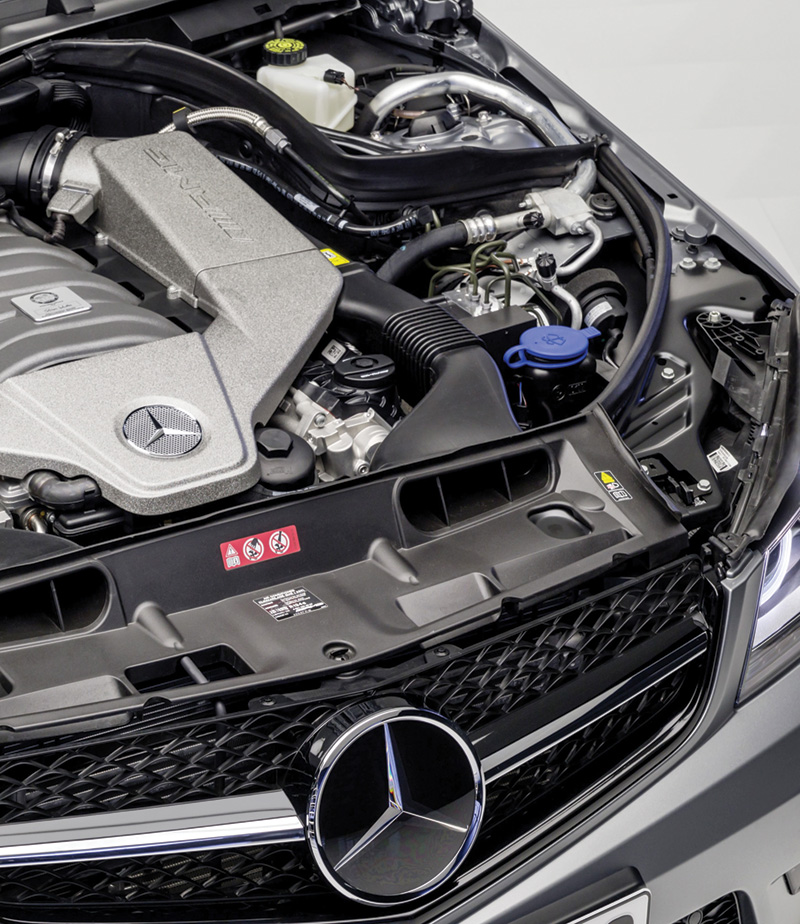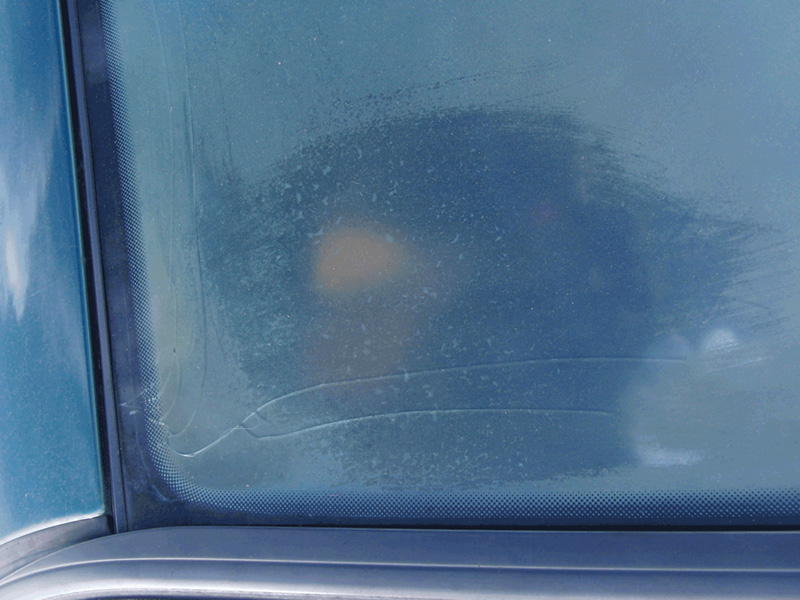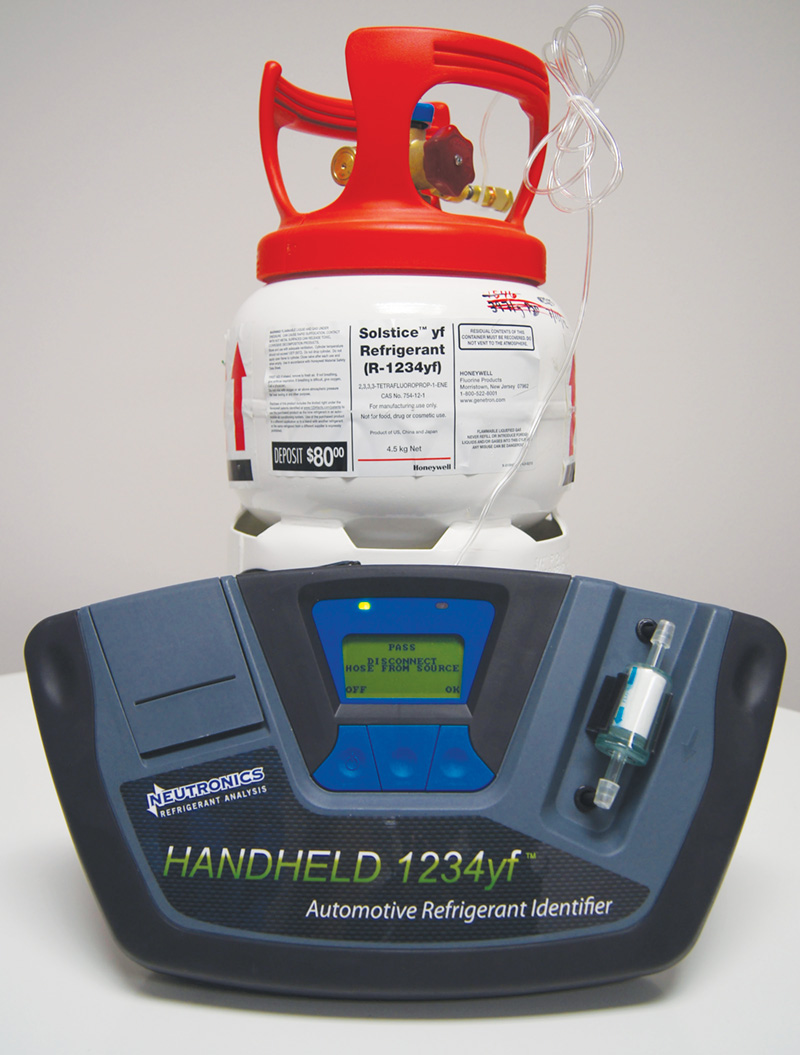“Due to the new findings of this study and the high safety demands at Mercedes-Benz, this chemical will not be used in its products,†the company states unequivocally.
“The company therefore wishes to continue to use the proven and safe R-134a refrigerant in its vehicles.â€

The 2014 C63 AMG is aggressive in appearance and performance. Where cabin climate control is concerned, it was designed to use HFO-1234yf as its refrigerant.
Mercedes-Benz has an unrivaled history of safety innovation that goes back more than 60 years. In 1951, the company introduced the first reinforced passenger compartment with front and rear crumple zones. It was also the first to use anti-lock brakes in 1978, traction control in 1986, air bags in the North American market in 1988, electronic stability control in 1995, side curtain airbags in 1998, adaptive high beams in 2009, among many other safety innovations.
So it should come as no surprise that, after extensive research has shown a flammability risk in vehicles using the European Union-mandated refrigerant HFO-1234yf, Mercedes-Benz was the first to reject its use. In a statement released in September, 2012, Mercedes-Benz manufacturer Daimler announced that it would not use HFO-1234yf in its vehicle A/C systems.
HFO-1234yf is a low global-warming potential (GWP) refrigerant that is a leading candidate to replace HFC-134a, the factory-installed refrigerant in use in most vehicles built in the past two decades. HFC-134a is being phased out worldwide in an effort to reduce the direct greenhouse gas emissions related to refrigerant use, and the indirect (CO2) emissions resulting from the increased fuel consumption required to operate mobile air conditioning compared to certain alternatives, such as CO2.
In addition to rejecting the use of HFO-1234yf in future vehicles, Daimler has begun retrofitting to HFC-134a its Mercedes-Benz vehicles that had already been produced with HFO-1234yf A/C systems and refrigerant. A company spokesperson said that such retrofitting is a temporary measure until safer and more environment-friendly refrigerants and mobile air conditioning technologies become available.
How we got here

The AMG’s A/C service ports are visible on the right. While not compatible with those for R-134a, they don’t look that much different, and a retrofit can easily be made.
Carbon dioxide (CO2) is the gas that is the largest single contributor to the “greenhouse effect,†which many believe causes global warming. For comparison purposes, the global warming impact of CO2 is pegged at 1, and the GWP of any other gas is measured in multiples of CO2. Using the CO2 yardstick, HFC-134a has a GWP of 1,430, meaning it is 1430 times more harmful to the atmosphere. The proposed new refrigerant HFO-1234yf has a GWP of 4.
The European Union’s European Commission (EC) in 2006 issued a Mobile Air Conditioning (MAC) Directive limiting passenger car refrigerant GWP to below 150 for any new types of vehicles manufactured beginning in 2011, and for all new vehicles registered in Europe beginning in 2017. The MAC Directive effectively bans HFC-134a from passenger car use.
U.S. refrigerant manufacturers DuPont and Honeywell co-developed HFO-1234yf, a fluorinated gas that meets the EC GWP requirements. The manufacturers claim that HFO-1234yf is a near drop-in replacement for HFC-134a. Its cooling capacity and COP (a ratio of cooling output to the compressor power required to generate that temperature change) are each within 5% of that of HFC-134a. Use of HFO-1234yf requires new vehicle manufacturers to make only minor A/C system design modifications, including new service fittings and a more substantial evaporator.
HFO-1234yf has a mild flammability risk that, according to Honeywell and DuPont, is contained with minimally modified A/C technology. Those modifications include routing A/C hoses away from high heat sources, as vehicle manufacturers do with fuel and hydraulic lines.
European companies including Daimler are less relaxed about flammability. They cite research showing that when burned, HFC-1234yf produces hydrogen fluoride (hydrofluoric acid), a highly toxic and corrosive gas. Daimler and other German carmakers lobbied for consideration of alternative refrigerants. The case for delay of MAC Directive enforcement was helped when Honeywell and DuPont reported they would not reach full production capability of HFC-1234yf until the fourth quarter of 2012 at the earliest. The European Commission delayed MAC Directive implementation until 2013 to build refrigerant production capacity and to allow manufacturers time to explore potential alternative MAC technologies.
Beyond laboratory tests

The hydrogen fluoride gas that’s produced when “twelve thirty-four†burns in the engine compartment quickly infiltrates the cabin. It’s so corrosive it etched this test car’s windows to the point of opacity. This photo is from UBA, the German Federal Environment Agency.
On three separate occasions in recent years, the Society of Automotive Engineers (SAE) International has organized Cooperative Research Projects (CRP) to investigate whether HFO-1234yf or some alternate refrigerant better meets mobile A/C safety and global warming standards. American, European, and Asian vehicle manufacturers, including Daimler, participated. HFO-1234yf passed the SAE cooperative research project testing. It met industry safety standards including those set by the U.S. EPA and the German Automotive Association.
Although Daimler participated in the SAE cooperative research project studies, the company saw a need to go beyond laboratory tests. It simulated a head-on collision by crashing a vehicle against a wall on a safety test track. The resulting refrigerant fire shows that there is a higher flammability risk than seen in lab tests, according to Daimler.
The company reports its test proves that in “a serious head-on collision in which the refrigerant line is severed… the refrigerant, which is otherwise difficult to ignite under laboratory conditions, can indeed prove to be flammable in a hot engine compartment. Similar tests of the current HFC-134a refrigerant did not result in ignition.â€
In the Daimler test, the HFO-1234yf refrigerant ignited within two seconds, and produced hydrogen fluoride. The corrosive gas penetrated the passenger compartment in high-enough quantity and potency to etch the windshield, turning it milky white. Hydrogen fluoride poses a serious health risk for passengers who may become exposed during a refrigerant fire in the aftermath of an automobile accident. Breathing hydrogen fluoride can burn lung tissue and cause swelling and fluid accumulation in the lungs, according to the U.S. Centers for Disease Control (CDC). Skin contact with hydrogen fluoride may cause severe burns.
Germany’s Federal Institute for Materials Research & Testing (BAM) conducted tests that support the Daimler findings. It set up release of HFO-1234yf in real cars and in high heat conditions that would encourage ignition. In its “Final Test Report on Ignition Behavior of HFO-1234yf,†BAM concluded that “in nearly all tests in which the refrigerant was released at specified test conditions the detected hydrogen fluoride amounts exceeded critical amounts for human health.â€
Concerns about potential skin burns and lung damage raised by its own and the BAM tests justified Daimler’s decision not to use HFO-1234yf in the A/C systems of its Mercedes-Benz vehicles. Daimler has made the results of its tests available to the SAE cooperative research project and to key automotive manufacturers and associations, and is actively encouraging the industry to explore alternatives to HFO-1234yf.
Wiggle room
In response to Daimler’s September 2012 announcement of its intent to continue using HFC-134a, the European Commission Technical Committee – Motor Vehicles (TCMV) announced in December that the MAC Directive would be enforced as planned beginning January 2013.
A European Commission “Framework Directive†issued in 2007 established legal guidelines for the vehicle “Type†approval process. However, the law is a bit vague about when a vehicle is considered a “new†type and must therefore meet the Type requirements of the Framework Directive. By simply not labeling their HFC-134a systems as part of a new vehicle “Typeâ€, manufacturers could continue using the existing refrigerant in 2013.
This uncertainty left room for Daimler and other interested parties to delay the launch of HFO-1234yf A/C systems in their 2013 vehicles. They have instead continued lobbying for MAC Directive approval of alternatives to HFO-1234yf.
The German Association of the Automotive Industry (VDA) said it may take at least half of a year “to quantify the risks further and develop appropriate countermeasures.†Options being considered include modifying the A/C system to enhance HFO-1234yf safety, re-formulating the refrigerant, or switching to a different refrigerant altogether. At least one other major German vehicle manufacturer has, since the Daimler announcement, publicly encouraged consideration of R744 (CO2).
Take another look
Although HFO-1234yf has been approved by previous SAE International CRP studies, Daimler’s 2012 rejection of the refrigerant led SAE to establish a new CRP team to update its review. The team includes thirteen global OEM members and is studying new data from several that completed HFO-1234yf tests after the prior CRP studies were finalized.
The CRP is also reviewing the design and safety requirements for potential use of R744 in mobile A/C systems. Systems must contain the higher operating pressures of R744 (up to 3,000 psi, or 200 Bar!), which is likely to drive vehicle production costs up. The design must also prevent release of CO2 into the passenger compartment, where it can impair the driver’s response to road conditions. If this containment requires underhood R744 heat reduction to be transmitted to another medium that travels through a “secondary loop†into the passenger compartment, system cost will increase and cooling efficiency will decrease. Publication of the CRP findings is planned for the second quarter of 2013.

Tool and equipment makers have been busy engineering products for this dubious new refrigerant, such as this highly-sensitive identifier. If the industry ends up leap-frogging to CO2 (also known as R-744) systems because of the anti-HFO-1234yf movement led by Mercedes-Benz, all that work may represent a dead end. (Courtesy Neutronics.)
HFO-1234yf and R744 Get U.S. SNAP Approval
The U.S. EPA Significant New Alternatives Policy (SNAP) program in 2012 listed both HFO-1234yf and R744 as acceptable substitutes for ozone-depleting refrigerants in mobile air conditioning systems. EPA made SNAP approval of R744 systems subject to the following conditions:
- CO2 levels in the passenger compartment must not exceed a short-term exposure level (STEL) of 3%, or 30,000 ppm, over a 15 minute period, and must not exceed an absolute limit of 4%, or 40,000 ppm. Vehicle manufacturers must test periodically and document over the first three years of a new CO2 system design that gas levels in the passenger compartment do not exceed these limits.
- The system must include a high-pressure cut-off switch and a high-pressure warning label to alert technicians of potential danger during service.
- Low- and high-side service ports must have fittings that differ in outside diameter from those of non-CO2 MAC systems.
Technician certification is necessary
SAE International has published new guidelines specifying what training a technician needs in order to properly diagnose and repair an A/C system that uses either HFO-1234yf, or R744. Technicians may be trained in either or both refrigerants. SAE standard J2845 requires that technicians be trained to correctly recognize which refrigerant a given vehicle or piece of equipment contains, and to understand how to handle the refrigerant safely and without release into the atmosphere. They must also have access to the relevant service procedure information and the equipment and tools that are required by law to be used with each refrigerant.
The Mobile Air Conditioning Society (MACS) Worldwide announced in September, 2012 that it has developed the first program to meet SAE J2845 training requirements. The MACS program trains technicians on the proper servicing of HFO-1234yf A/C systems.
The U.S. EPA has yet to announce any changes to its Section 609 technician certification requirements. However, the mild flammability of HFO-1234yf and the higher pressures and driver impairment potential of R744 suggest that the agency will make the training specified in SAE J2845 mandatory.
The lure of easy money

For the time being, there’s no reason for you to worry about anything beyond your supply of trusty and much less expensive R-134a.
HFO-1234yf may cost as much as ten times more per ounce than HFC-134a. Environmental groups complain that the price differential is a major temptation to re-charge an HFO-1234yf system with HFC-134a. The fact that both refrigerants are compatible with most components of the newer system makes it easy to substitute HFC-134a during a repair.
If a shop gives the customer the choice, many will take the lower cost option. An unscrupulous shop can simply add the lower-cost HFC-134a, charge the HFO-1234yf price, and pocket the difference. Either way, the likelihood that the vehicle gets HFC-134a is high, and the claimed environmental benefit of the switch to HFO-1234yf is lost.
High stakes
The Daimler rejection of HFO-1234yf has the mobile air conditioning industry holding its collective breath. A/C system developers, vehicle manufacturers, tool and equipment makers, and service providers have all invested significantly in HFO-1234yf. Only a few vehicles have so far entered the U.S. market with HFO-1234yf installed. Some carmakers have said they plan to introduce HFO-1234yf into their lines over the next few years, and others have been testing and tooling up for their entries.
As far as you, the independent auto service specialist, are concerned, the most important thing to understand from this complicated, politically-fraught situation is that you should hold off on purchasing dedicated HFO-1234yf service equipment, or attending training on this refrigerant for the time being. Daimler’s safety innovations have changed the automotive landscape many times before. With this leadership stance against HFO-1234yf, it may do so again.Â






0 Comments